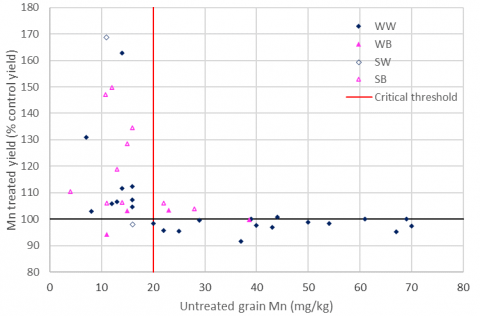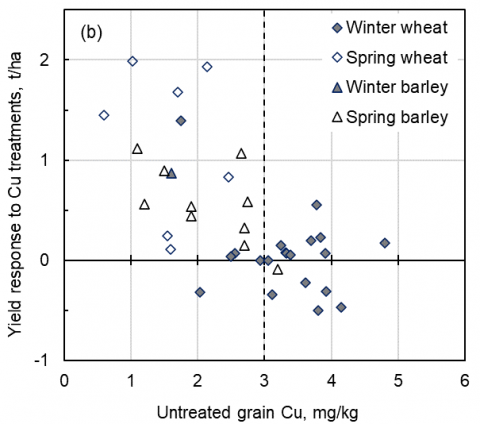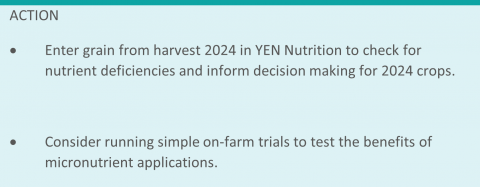Susie Roques
The major nutrients nitrogen (N), phosphorus (P), potassium (K) and sulphur (S) are well understood and the AHDB Nutrient Management Guide (RB209) contains detailed guidance on meeting crop requirements, based on large numbers of yield response experiments.
Guidance on other eight essential nutrients (magnesium (Mg), calcium (Ca), iron (Fe), manganese (Mn), zinc (Zn), copper (Cu), boron (B) and molybdenum (Mo)) is less solid: conventional advice is to apply them only when soil or tissue analyses or crop symptoms indicate deficiency, but some sources suggest that economic yield responses often occur in the absence of deficiency symptoms (‘hidden hunger’).
If you are advised to apply micronutrients but are unsure of the necessity, consider running your own simple on farm trials to test the benefits – see our free trials guide for guidance or email agronomics@adas.co.uk to register your interest in hosting ADAS trials. Or if you have already trialled micronutrient applications on farm, why not share your results on www.farmpep.net?
Also, watch out next year for the results of a 2024-25 trial at AHDB’s Strategic Farm North, in which host farmer David Blacker will compare a ‘responsive’ approach to nutrition, applying minor nutrients according to in-season test results, against a more basic approach to nutrition.
YEN Nutrition
ADAS is seeking to better understand the prevalence of and thresholds for nutrient deficiencies using grain analysis, in the YEN Nutrition project. Tissue nutrient concentrations can vary with growth stage and leaf maturity, making interpretation challenging, but grain concentrations present a consistent ‘post-mortem’ of crop nutrition in the past season, to inform nutrition choices for following crops. Meanwhile, the accumulated grain analysis data will help us develop improved nutrition guidance for the industry.
We recommend that farms submit samples from around six fields – perhaps from different crops in the rotation, or the same crop on different parts of the farm. We have found that on many farms, multiple crops or fields show the same pattern of deficiency in a particular nutrient; this gives a clear focus for action in the following season. However, nutrient deficiencies may result from insufficient supply or from poor uptake (e.g. compaction or waterlogging hindering rooting), so in some cases the best action may be seeking ways to improve soil structure and rooting, rather than increasing nutrient applications; this is particularly relevant where soil structure has been badly impacted by waterlogging in the 2024 season.
Now is a good time to enter grain samples from harvest 2024 in YEN Nutrition, to receive benchmark reports in time to help you plan nutrition programmes for 2024-25 crops.
Manganese
For tissue samples collected during the growing season, Mn levels below 20 mg/kg are a good indicator of deficiency and a predictor of a yield response to Mn applications (foliar or seed treatments), as shown by data collected for the 2013 AHDB-funded review of non-NPKS nutrients (Figure 1). Soil Mn tests do not provide a useful predictor of yield response, but high soil pH increases the proportion of crops responding to Mn applications.

Figure 1. Relationship between tissue manganese levels and cereal yield responses to manganese applications. Mean treated yields are shown as a percentage of untreated control yield and include foliar treatments, seed treatments, broadcast and soil incorporated treatments (Roques et al., 2013, AHDB RR78).
Data on grain Mn is more limited but supports the same threshold of 20 mg/kg as indicating deficiency. Across multiple years of YEN data, manganese levels in grain have been higher in wheat than barley, with more than 90% of barley samples below the threshold of 20 mg/kg thought to indicate deficiency. Work is ongoing to establish whether this shows genuine widespread Mn deficiency in barley, or whether the critical value for barley should be revised relative to other cereals.
Copper
Large yield responses to copper (Cu) have only been recorded on soils with <2 mg/kg, which are rare in the UK. As for Mn, a review of past experiments shows that grain Cu is a good indicator of deficiency (Figure 2), with <3 mg/kg grain Cu showing that Cu applications should be considered for following crops. The risk of copper deficiency is greatest for peats or coarse sandy soils. Soil Cu status does not change much from year to year and soil-applied treatments can give yield results for several years after application, so even at high-risk sites it is only necessary to test soil every few years. Cu deficiency is a greater risk in barley than wheat, and in spring barley than winter barley. Oilseed rape is thought to be more tolerant than cereals to low Cu supply.
However, analysis of the YEN database has indicated a link between copper nutrition (mg/kg grain copper) and spikelet fertility (grains per spikelet and grains per ear), so we hope to investigate next season whether foliar copper applications in late spring could boost grain numbers.

Figure 2. Relationship between grain copper levels and cereal yield responses to copper application. Mean treated yields include foliar treatments, seed treatments, broadcast and soil incorporated treatments (from Sylvester-Bradley et al. 2022. Nutrient harvests: the essential yardstick to transform crop nutrition. IFS conference proceedings 874).
Boron
Boron (B) applications are often recommended for oilseed rape, but the AHDB review found little trial data to support this advice. Significant yield responses to B applications occurred in only five out of 48 experiments, and across all experiments the average B treated yield was only 100.3% of the untreated yield. No correlations were found between soil or tissue B levels and oilseed rape yield response to foliar B applications, and no seed analysis data was available. The review also found 33 experiments testing cereal responses to B, none of which gave significant yield responses.
Other nutrients
Magnesium (Mg) is considered a major nutrient, not a micronutrient, because it is found at g/kg levels in plants. However, good trial data is scarce because Mg is usually applied as magnesium sulphate, so unless control treatments balance the sulphur application, it is impossible to separate the effects of Mg and S fertilisation. Data on crop responses to zinc (Zn), molybdenum (Mo) and other micronutrients are similarly limited.

